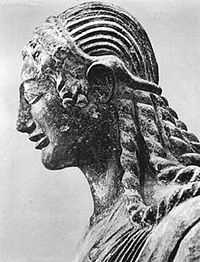Etruscan cities

Etruscan cities flourished over most of Italy during the Roman Iron Age, marking the farthest extent of Etruscan civilization. They were gradually assimilated first by Italics in the south, then by Celts in the north and finally in Etruria itself by the growing Roman Republic.
That many Roman cities were formerly Etruscan was well known to all the Roman authors. The Etruscan names of the major cities in this category survived in inscriptions and are listed below. Some cities were founded by Etruscans in prehistoric times and bore entirely Etruscan names. Others were colonized by Etruscans who Etruscanized the name, usually Italic.
The estimates for the largest cities (Veii, Volsinii, Caere, Vulci, Tarquinia, Populonia) range between 25,000 to 40,000 in the 6th century BC.[1][2][3][4]
Twelve cities
History is most ample concerning the Dodecapoli, the "twelve cities" of the Etruscan League. They have no completely authoritative roster. George Dennis[5] summarizes an explanation that:
Where Livy mentions the Twelve Cities, after the fall of Veii (VII.21), it can only mean that the number being a fixed one ... the place of the city that was separated was immediately supplied by another....
By the time the Etrurian twelve spring into the light of history, the Etruscan cities to the north have been assimilated by invasions of the Celts, and those of the south by infiltration of the Italics. The table below lists Etruscan cities most often included in the Dodecapoli as well as other cities for which there is any substantial evidence that they were once inhabited by Etruscans in any capacity. Roman and Italian names are given, but they are not necessarily etymologically related. Relationships generally tend to be obvious. For sources and etymologies (if any) refer to the linked articles.[6]
Etruscan cities were autonomous states, but they were linked in this League of Twelve Cities and had a federal sanctuary at the Fanum Voltumnae near Volsinii.[7]
According to Roman historian Pliny the Elder[8] the city of Bolsena was entirely burned up by a bolt from Mars.
Table of cities in Etruscan, Latin and Italian
|
| ||||||||||||||||||||||||||||||||||||||||||||||||||||||||||||||||||||||||||||||||||||||||||||||||||||||||||||||||||||||||||||||||||||||||||||||||||||||||||||||||||||||||||||||||||||||||||||||||||||||||||||||||||||||||||||||||||||||||||||||||||||||||||||||||||||||||||||||||||||||||||||||||||||||||||||||||||||||||||||||||||||||||||||||||||||||||||||||||||||||||||||||||||||||||||||||||||||||||||||||||||||||||||||||||||||||||||||||||||||||||||||||||||||||||||||||||||||||||||
References
- ↑ "The Etruscan World". Books.google.dk. Retrieved 24 October 2014.
- ↑ "An Historical Geography of Europe 450 B.C.-A.D. 1330". Books.google.dk. Retrieved 24 October 2014.
- ↑ "The Process of Urbanization of Etruscan Settlements from the Late Villanovan to the Late Archaic Period (End of the Eighth to the Beginning of the Fifth Century B.C.) : Presentation of a Project and Preliminary Results" (PDF). Scholarworks.umass.edu. Retrieved 24 October 2014.
- ↑ "Production, Consumption and Society in North Etruria During the Archaic and ...". Books.google.dk. Retrieved 24 October 2014.
- ↑ Appendix to Chapter I, Note IV.
- ↑ The Bonfantes (2002) pages 222-223 have published a good overall list.
- ↑ Cary, M.; H.H. Scullard (1979). A History of Rome (3rd ed.). p. 25. ISBN 0-312-38395-9.
- ↑ Natural History, II, 18
- ↑ Parts of ancient Etruria near Rome are now in Lazio. This account accepts the ancient boundary along the Tiber.
Bibliography
- Bonfante, G.; L. Bonfante (2002). The Etruscan Language. An Introduction. Manchester University Press.
- Dennis, George (1848). The Cities and Cemeteries of Etruria. London: John Murray. Available in the Gazeteer of Bill Thayer's Website at
External links
| |||||||||||||||||||||||||||||||||
